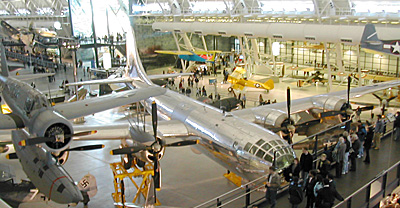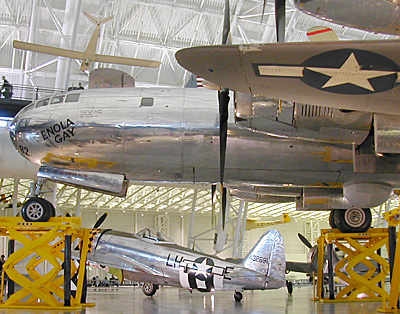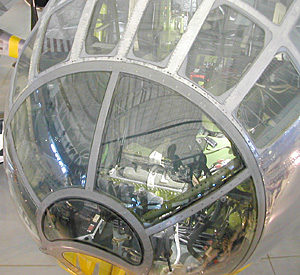 The B-29 is generally remembered as the warplane which, on 6 and 9 August 1945, dropped atomic weapons that destroyed the cities of Hiroshima ("Enola Gay") and Nagasaki ("Bock's Car"), persuading the Japanese to surrender.
The B-29 is generally remembered as the warplane which, on 6 and 9 August 1945, dropped atomic weapons that destroyed the cities of Hiroshima ("Enola Gay") and Nagasaki ("Bock's Car"), persuading the Japanese to surrender.
Even a view from the "third floor" walkway has a tough time showing the B-29 in its entirety.
Yet by this time the B-29 had been at the forefront of a campaign to neutralise the war-making potential of Japan by burning her cities, destroying her communications network and crippling her industries. First entering service from the summer of 1944, the Superfortress was an extremely clean bomber with turbocharged engines. The baseline B-29, of which 2458 were completed, was complemented by the B-29A of which 1119 were manufactured with greater span and a four- rather than two-gun forward dorsal barbette, and the B-29B of which 310 were delivered with reduced defensive armament but a greater bomb load and higher speed.
 B-29 "Enola Gay" -- centerpiece of WWII collection -- hoisted above the floor...and above the P-47D in background. The wingtip with the American star is that of the P-38J.
B-29 "Enola Gay" -- centerpiece of WWII collection -- hoisted above the floor...and above the P-47D in background. The wingtip with the American star is that of the P-38J.
Country of origin: USA
Type: (B-29) nine-seat long-range heavy bomber
Powerplant: four 2200hp (1640kW) Wright R-3350-23 18-cylinder two-row radial engines
Performance: maximum speed 576km/h (358mph); climb to 6095m (20,000ft) in 38 minutes; service ceiling 9710m (31,850ft); range 9382km (5830 miles)
Weights: empty 31,816kg (70,140lb); normal take-off 47,628kg (105,000lb); maximum take-off 56,246kg (124,000lb)
Dimensions: span 43.05m (141ft 2.75in); length 30.18m (99ft); height 9.02m (29ft 7in)
Armament: one 20mm trainable rearward-firing cannon and two 0.5in trainable rearward-firing machine guns in the tail position, and two 0.5in trainable machine guns in each of two dorsal and two ventral barbettes, plus an internal bomb load of 9072kg (20,000lb)
 The nose of the B-29 Enola Gay, although with more glare than detail.
The nose of the B-29 Enola Gay, although with more glare than detail.
Text from: Aircraft of WWII by Chris Chant (Fiedman/Fairfax, 1999, ISBN: 1-58663-303-1), a handy book with specs for 300 aircraft.
WWI
WWII
Japan: Kawanichi N1K2-Ja Shinden Kai (George)
US: Curtiss P40 Tomahawk
Post WWII
US: Northrop N-1M Flying Wing
Other
UHC Displays
Germany: Focke-Wulf FW-190F
Germany: Arado AR-234B
Germany: Junkers JU-52/3m
Germany: Focke-Achgelis FA-330A
Germany: Rheintochter R1 Anti-aircraft Missile (Rhine Maiden)
Japan: Kawasaki Ki-45 Kai Toryu (Nick)
Japan: Aichi M6A1 Seiran
Japan: Kugisho Ohka Model 22 Cherry Blossom
US: Vought F4U Corsair
US: Lockheed P-38J Lightning
US: Boeing B-29 Superfortress "Enola Gay"
US: Grumman F6F Hellcat
US: Republic P-47D Thunderbolt
UK: DeHavilland DHC-1A Chipmunk
US: Lockheed SR-71 Blackbird
US: Space Shuttle "Enterprise"
US: Lockheed Martin X35b Joint Strike Fighter
Back to List of Historic Sites
Back to Travel Master List
Back to MagWeb Master List of Magazines
© Copyright 2004 by Coalition Web, Inc.
This article appears in MagWeb.com (Magazine Web) on the Internet World Wide Web.
Other articles covering military history and related topics are available at http://www.magweb.com